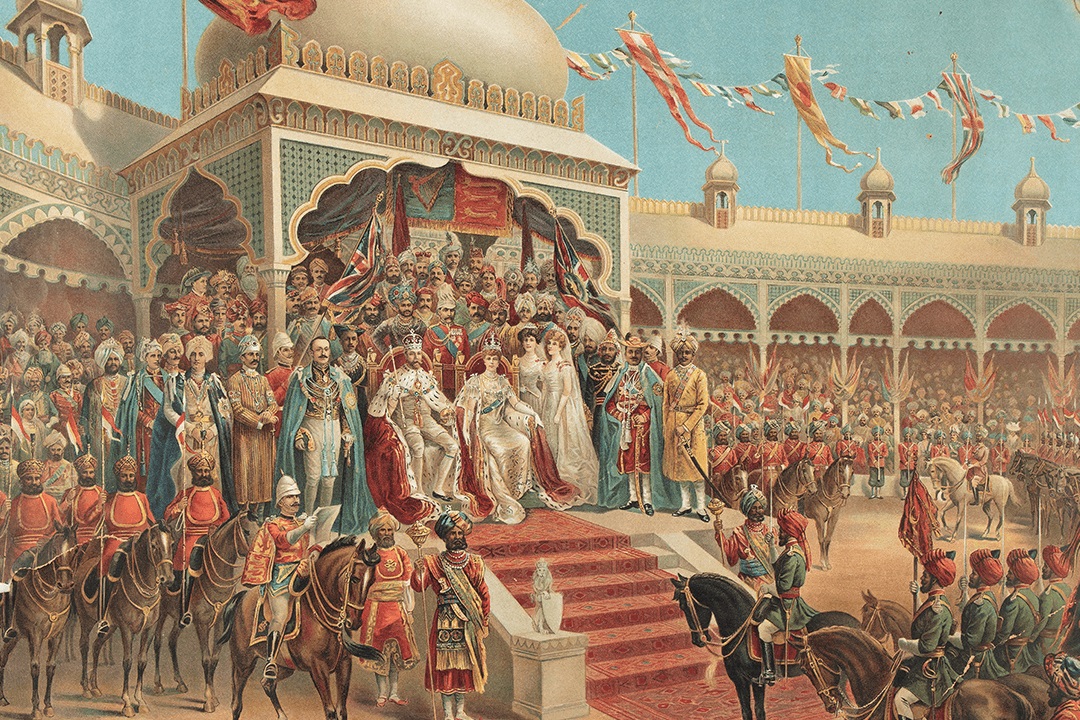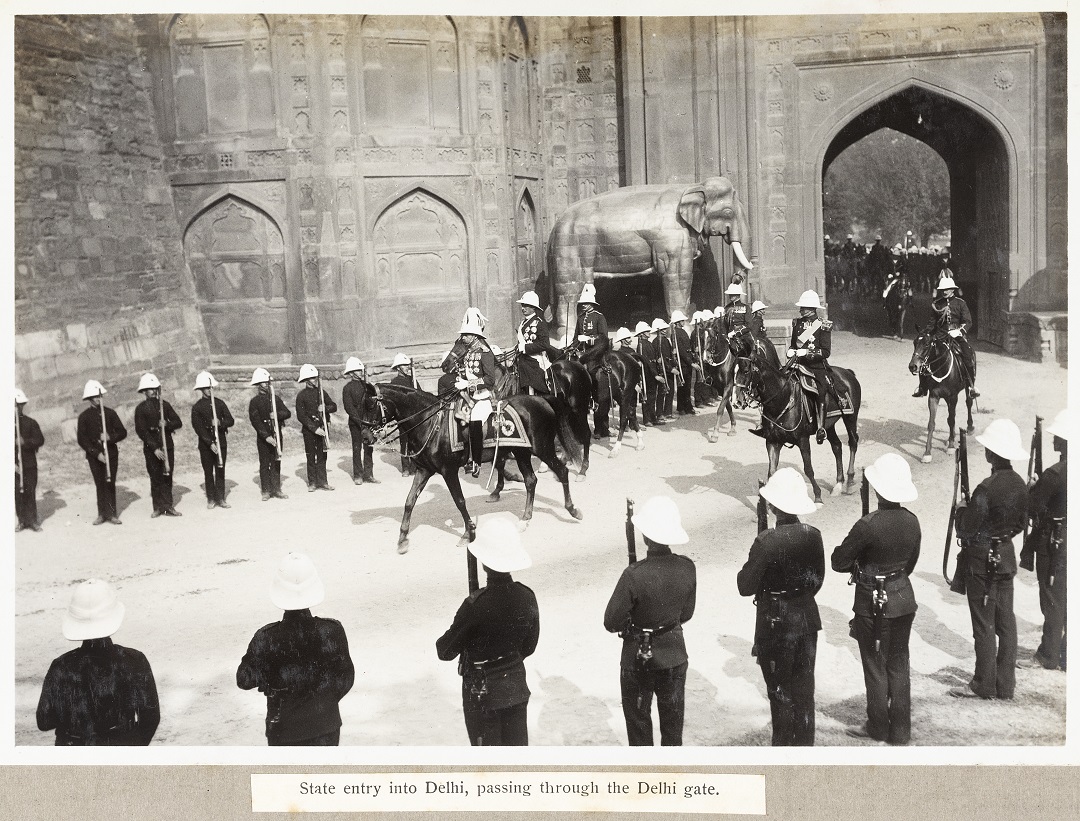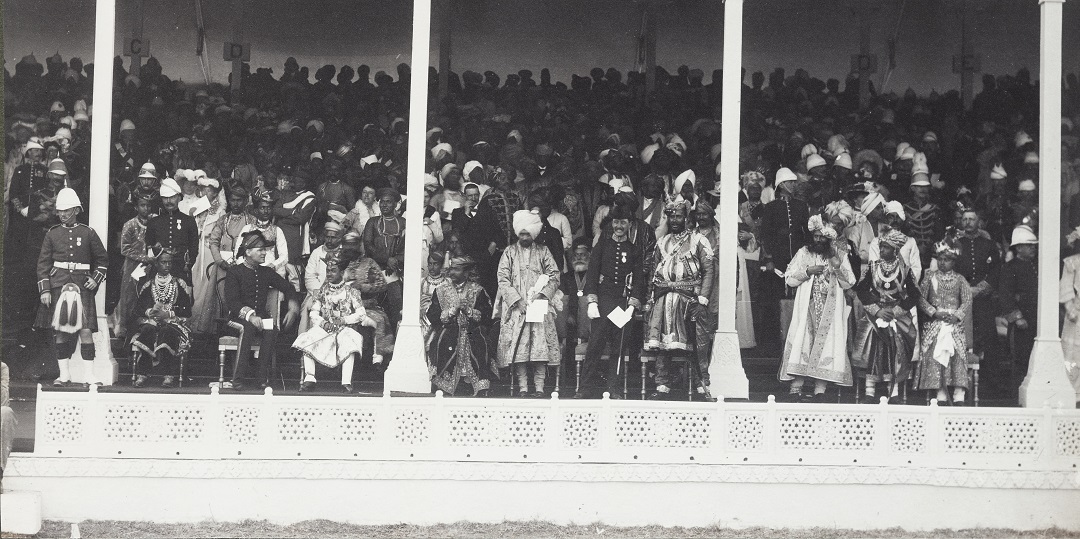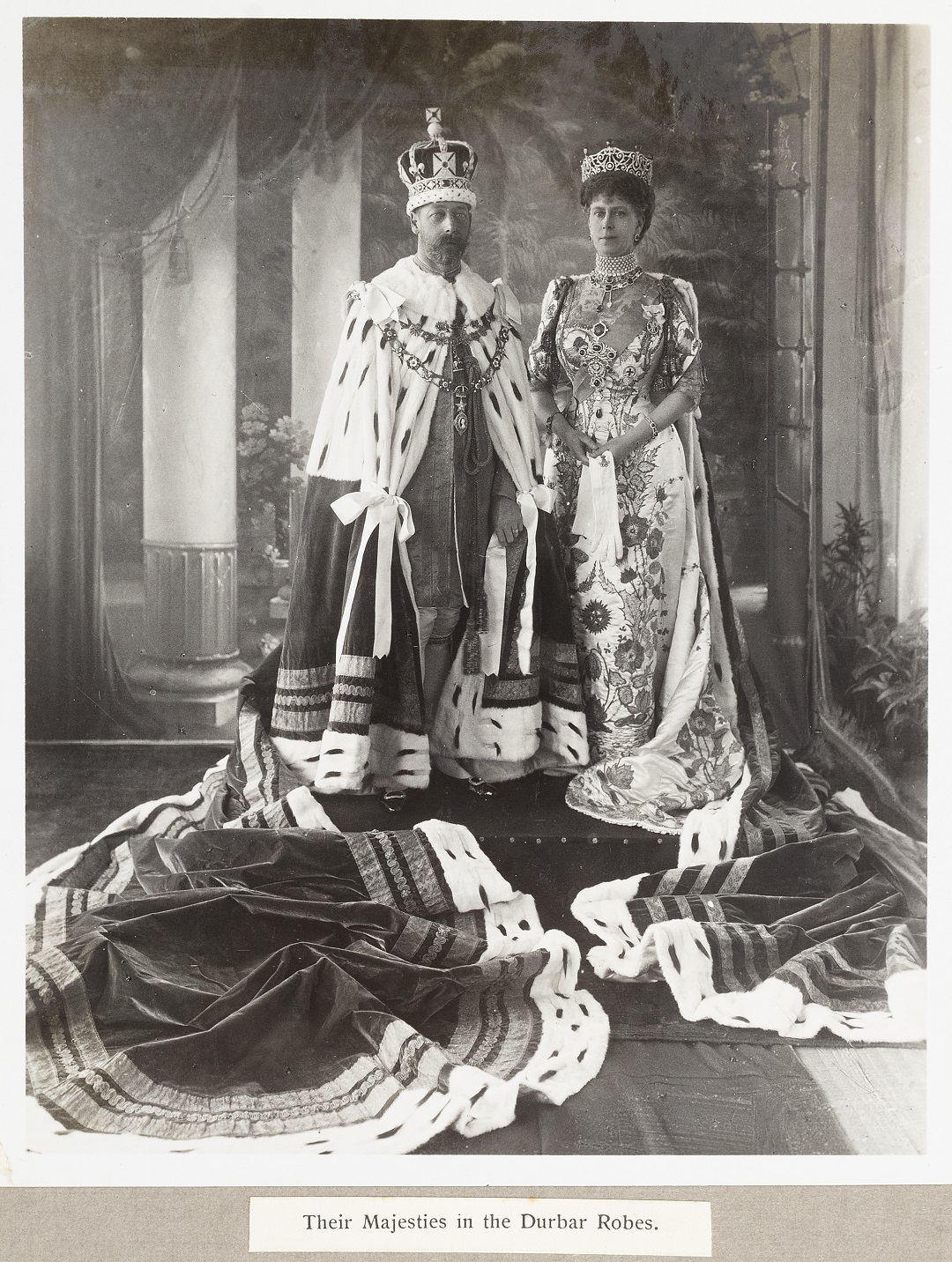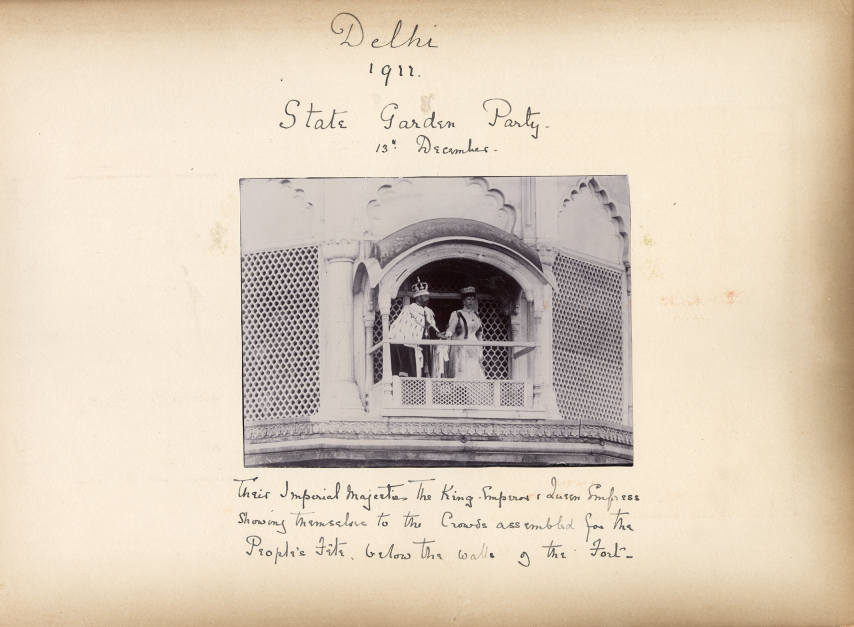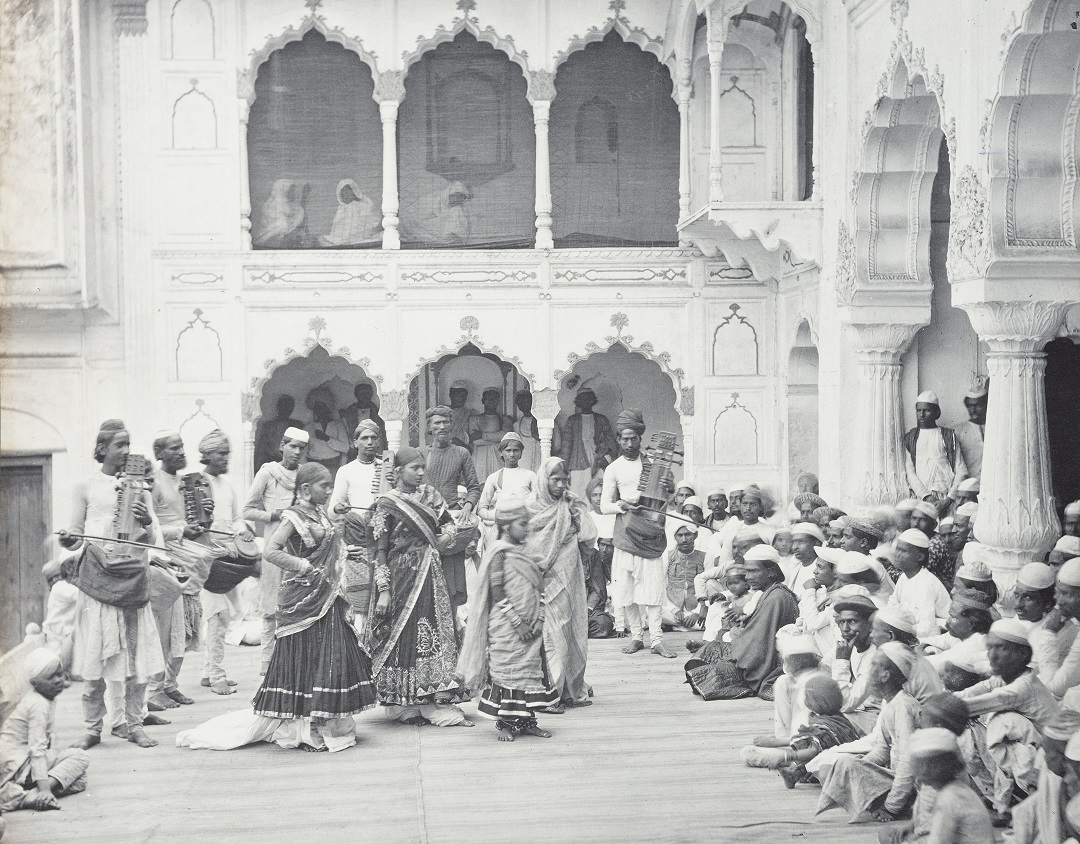An Imperial Spectacle: The Delhi Durbars and its Ceremonies
An Imperial Spectacle: The Delhi Durbars and its Ceremonies
An Imperial Spectacle: The Delhi Durbars and its Ceremonies
collection stories
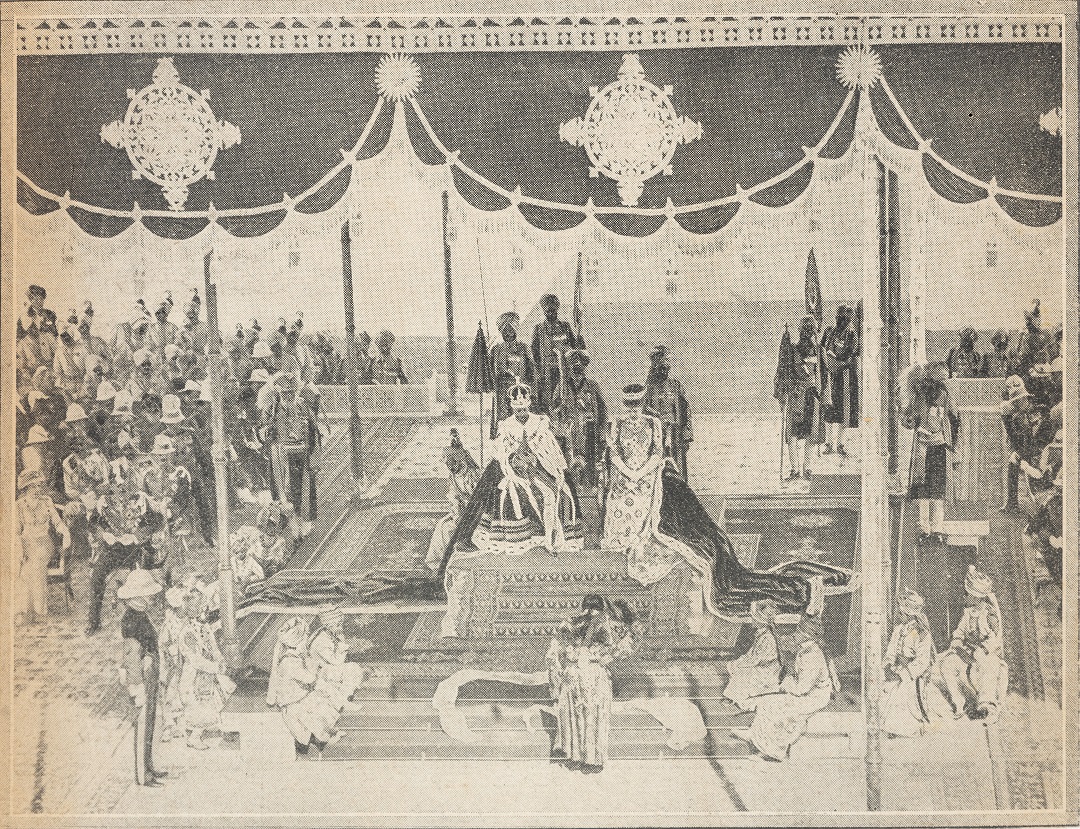
Anonymous
Coronation Durbar
1912
Print on paper, mounted on card
This photograph is from an article written in The Daily Telegraph dated 1 January 1912, which covered the various events of the Delhi Durbar of 1911. But if the Delhi Durbars were essentially coronation events, why was so much attention paid to organising these additional ceremonies? Did they serve any purpose other than adding to the opulence of the Durbars? |

Ernest Brooks (attributed)
King George V and Queen Mary at The Red Fort Balcony (from the album "King Emperor's Indian Durbar Tour of 1911- 1912")
1911
Silver gelatin print on paper, mounted on card
Collection: DAG
The Delhi Durbars were a series of coronation events held by the British in India which formally declared the British monarch as the Emperor or Empress of India. They took place thrice—first, in 1887, acknowledging Queen Victoria as the Empress of India, followed by one in 1903, for King Edward VII, and finally in 1911 for King George V, which saw the monarch’s attendance in person. |
|
The State Entry and Grand Elephant Procession |
|
Anonymous An Official State Entry Procession, 1911 1911 Silver gelatin print on paper, mounted on card |

Anonymous
The Durbar Procession
1911
Silver gelatin print on paper
'Every spectator amongst all those thousands felt the impressiveness of the moment. Every eye was strained for the first sight of the glittering throng. Everyone was waiting for the first note of the National Anthem. Slowly the blazing procession came into view, unwinding itself and presenting a wholly new scheme of colour every moment. Each instant produced its own glory.' – Dorothy Menpes, The Durbar The Durbar (a first edition of which is present in the DAG Archive’s library) contains British painter and printmaker Mortimer Menpes's account of the 1903 Durbar, where he was present as an esteemed guest. This account on the State Entry not only give us a perspective on how guests reacted to the visuals of the procession but how the grandeur of the ceremonies were recorded and conveyed through such written or illustrated accounts. |
Anonymous
An Official State Entry Procession, 1911
Bourne and Shepherd
Their Excellencies Lord and Lady Curzon on the State Elephant “Lutchmann Pershad” Bourne and Shepherd (from the album "The Coronation Durbar Delhi, 1903")
Bourne and Shepherd
The State Entry (from the album "The Coronation Durbar Delhi, 1903")
Anonymous
State Entry into Delhi, passing through the Delhi gate (from the album "King Emperor's Indian Durbar Tour of 1911- 1912")
|
The Coronation Ceremony |
|
Anonymous A Distant View of the Amphitheatre c. 1902-1903 Silver albumen print on paper |
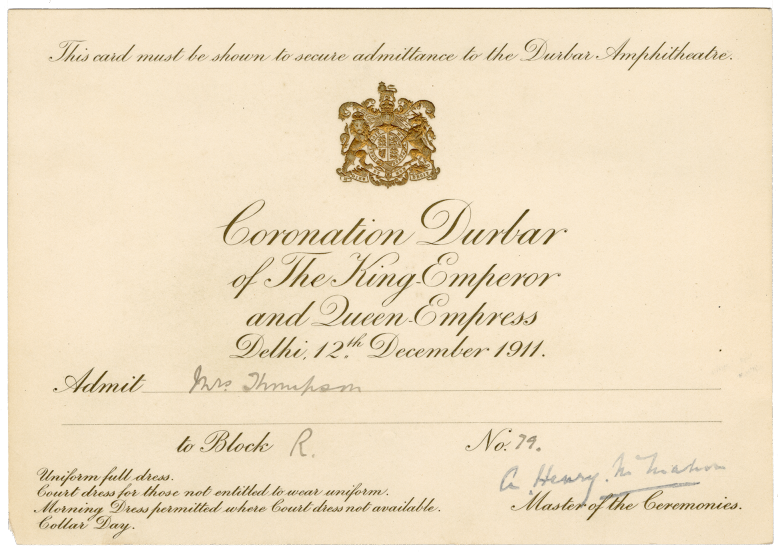
The Coronation Durbar invite, 1911
1911
Print, ink and graphite on paper
This is the official invitation for the main event of the Delhi Durbar of 1911—The Coronation Ceremony. While the ‘durbar’ appropriated the Indian medieval tradition to present the British Monarch as the 'heir' of the Mughals in India, sending out invitations was essentially a British tradition. This was one of the many ways in which the coronation ceremony incorporated political and cultural conventions that resonated with both countries. |
Bourne and Shepherd
The Coronation Ceremony (from the album "The Coronation Durbar Delhi, 1903")
Bourne and Shepherd
The Amphitheatre (from the album "The Coronation Durbar Delhi, 1903")
Herzog and Higgins (attributed)
Their Majesties in the Durbar Robes. (from the album "King Emperor's Indian Durbar Tour of 1911- 1912")
|
Investiture Ceremonies: Symbols of Allegiance to the British Crown |
|
The Ruling Princes of India c. 1930s Oleograph on paper |

A.H. McMahon
Official Notice for Investiture Ceremony, 1911
1911
Print and graphite on paper
This is the official notice for the investiture ceremony of the 1911 Delhi Coronation Durbar held on 14 December. Investiture ceremonies were primarily organised to commemorate the Maharajas of Princely states and high-ranking government officials for their loyalty and subservience to the British Crown. What information do you think would generally be included in such a notice? Does this one contain anything different? |

|
These are some of the commemorative medals which are a part of the DAG Archives' durbar collection. Both British government officials and rulers of Indian Princely states were appointed to prominent Orders introduced during the Durbar of 1877. Over the years, they became a powerful marker of allegiance to the monarchy especially during the third durbar, when the spirit of nationalism was on the rise. Explore |
|
Exhibiting 'Indian' Art- The Art Exhibition at the Delhi Durbar of 1903 It is now my pleasant duty to proceed to the first of the functions of the present fortnight, and to declare open the Delhi Art Exhibition… Ever since I have been in India, I have made a careful study of the art, industries and handicrafts of this country, once so famous and beautiful, and I have lamented, as many others have done, their progressive deterioration and decline. When it was settled that we were to hold this great gathering at Delhi, it struck me that here at last was the long-sought opportunity of doing something to resuscitate these threatened handicrafts, to show the world of what India is still capable, and, if possible, to arrest the process of decay.’ |
|
Bourne and Shepherd The Opening of The Indian Arts Exhibition (from an album titled "The Coronation Durbar Delhi, 1903") 1903 Platinum print on paper, mounted on paper |

Bourne and Shepherd
The Opening of The Indian Arts Exhibition (from the album "The Coronation Durbar Delhi, 1903")
1903
Platinum print on paper, mounted on paper
Collection: DAG
This Saracenic style building was constructed at Qudsia Bagh solely for the 1903 Delhi Art Exhibition. The massive crowd you see in front of the building is of the queue of hundreds of visitors from around the world, all lined up to look at the exhibition put up by Lord Curzon. The exhibition was curated in a manner that highlighted the 'threatened' indigenous art of India, carefully excluding all traces of what was perceived as foreign influences. Thus, galleries were filled with works of fine muslin, silk and embroidered Indian brocades, gold and silver wares, wood carvings, pottery, along with metal and enamel work. |
|
Celebrating the Empire: Garden Parties, Coronation Balls and other Festivities The coronation ceremony for each of the Durbars was followed by a string of celebratory events comprising lavish banquets, musical performances, firework displays, and garden parties. |
|
Herzog and Higgins Scene at the Garden Party, Delhi (from the album "King Emperor's Indian Durbar Tour of 1911- 1912") 1911 Silver gelatin print on paper, mounted on card |
Unknown photographer
Jharokha Darshan at the State Garden Party, 1911
Bourne and Shepherd
A Delhi Nautch (from the album "The Coronation Durbar Delhi, 1903")
Bourne and Shepherd
The Devil Dancers from Ladakh (from the album "The Coronation Durbar Delhi, 1903")
|
The Games of the Coronation Durbars Sports had always played an integral role in the maintenance and celebration of the British Raj. As means of sharing common roots with colonies and a sense of Britishness that upheld values of camaraderie and sportsmanship, sporting tournaments became primary sources of entertainment at British colonial events. The Delhi Coronation Durbars were no exceptions, with tournaments in place for polo, football, hockey, cricket and even wrestling. |
|
Anonymous The Polo Match (from the album "King Emperor's Indian Durbar Tour of 1911- 1912") c. 1911-1912 Silver gelatin print on paper, mounted on card |

Unknown photographer
Winners of the Polo Tournament Posing with their Victory Trophy
c. 1902-1903
Silver albumen print on paper, mounted on card
For the Polo tournaments at the Durbar, a special Delhi Durbar Polo Club was open for the season between December and January. Its membership was rather exclusive and involved a fee. Two separate tournaments were announced for the game—an International Cup, open to any team from India or abroad, and a Native Army Cup, strictly meant for the regiments of the native army. While the former allowed twenty-four ponies per team, the latter was limited to eighteen. |
|
Epilogue: Subverting Rituals of Power |
|
Anonymous The Shamiana or Central Dais 1903 Silver albumen print on paper, mounted on card |

Anonymous
An Official Delhi Durbar Directory
1903
Print and ink on paper, hardcover leather binding
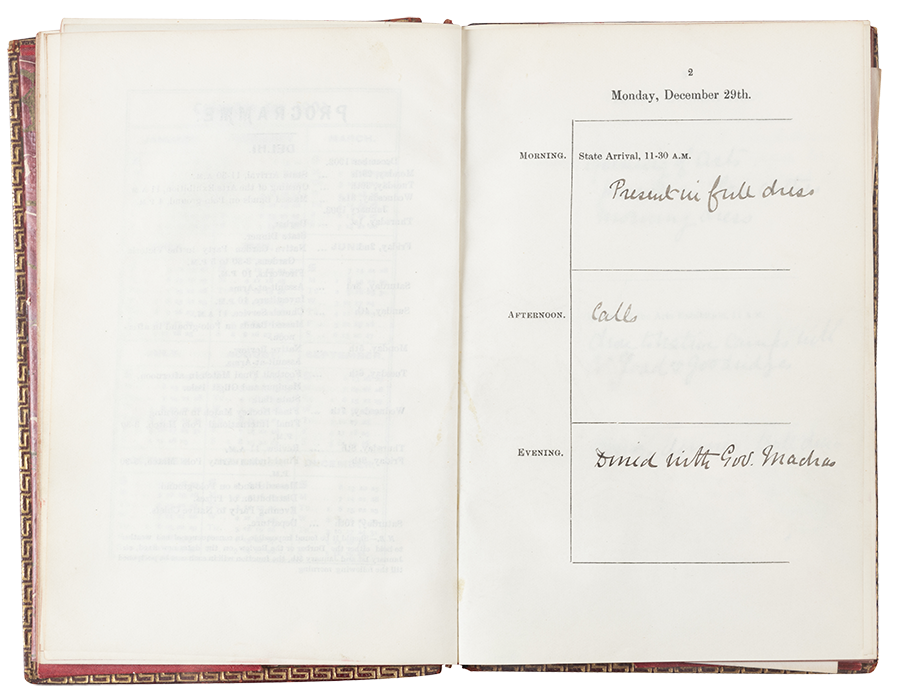
Anonymous
An Official Delhi Durbar Directory
1903
Print and ink on paper, hardcover leather binding

Anonymous
An Official Delhi Durbar Directory
1903
Print and ink on paper, hardcover leather binding

Anonymous
An Official Delhi Durbar Directory
1903
Print and ink on paper, hardcover leather binding

Anonymous
An Official Delhi Durbar Directory
1903
Print and ink on paper, hardcover leather binding
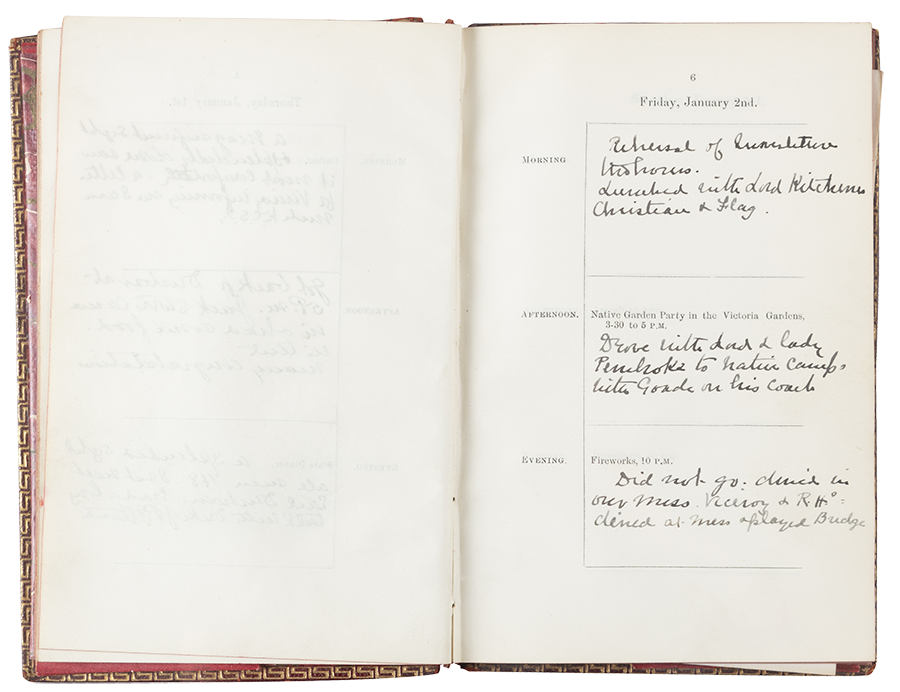
Anonymous
An Official Delhi Durbar Directory
1903
Print and ink on paper, hardcover leather binding
Here are a few pages from an official Durbar directory presented to each guest at the 1903 Durbar—a little red diary which outlined the schedule of events and guidelines for the ceremonies. This diary seems to belong to a British government official, identifiable through some of the anecdotes on his itinerary. Do you notice that each note of an appointment is accompanied by a remark on the dress code required for the event. So how important were these social codes of etiquette, dress, and formalities? |

Bourne and Shepherd
The Maharaja of Travancore (from the album "The Coronation Durbar Delhi, 1903")
1903
Platinum print on paper, mounted on paper
Collection: DAG
We see that the coronation durbars were superb examples of elaborate gatherings, where each aspect was painstakingly planned and accounted for. Seating arrangements, the order of entries, the state retinues, and rules of homage were all ways devised to establish and maintain the superiority of the Crown. The rulers of the princely states were mandated to wear their state jewels and formal dress during the homage ritual. Here, we have the Maharaja of Travancore dressed in his state attire, adorned with the sash and medal of the Order he received during the Durbar of 1911. |

Bourne and Shepherd
His Highness The Maharaja Gaekwar of Baroda, G.C.S.I. (from the album "The Coronation Durbar Delhi, 1903")
1903
Platinum print on paper, mounted on paper
Collection:DAG
Interestingly, at the Durbar of 1911, The Gaekwad of Baroda, Sayajirao III violated this social code, appearing in front of the emperor to pay homage, after taking off all his adornments. He wore a simple white dress with only his medals. He apparently turned his back on King George V too quickly before walking off. His simple disregard for royal etiquette was considered an act of dissent, making headlines in the press. The question then arises, to what extent can one look at the durbar ceremonies as less of formal coronation events, and more of carefully choreographed performances which employed the theatricality of rituals, dress, and investitures as symbolic actions to establish the legitimacy and authority of the British Crown? |
Your Views

|
We are always interested in learning more about our collection from viewers like you. If you have any information or interpretation you would like to share, please let us know below. This circular cloth, embroidered with the Coronation emblem, was made in Surat, Gujarat specially for the Durbar of 1911. After reading what is written on the cloth, what do you think it could have been used for? |
further reading
Codell, Julie F. Power and Resistance: the Delhi Coronation Durbars, 1877, 1903, 1911 Ahmedabad, India: Mapin and The Alkazi Collection of Photography, 2012.
Menpes, M. The Durbar, London: Adam and Charles Black, 1903.
Agarwal, R and Rahman, S. Delhi Durbar 1911: The Complete Story, Lotus, 2016.
Credits
Written by Aditi Mazumdar
Archival material curated by Sanjana S.



